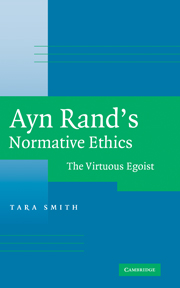Book contents
- Frontmatter
- Contents
- Acknowledgments
- 1 Introduction
- 2 Rational Egoism: A Profile of Its Foundations and Basic Character
- 3 The Master Virtue: Rationality
- 4 Honesty
- 5 Independence
- 6 Justice
- 7 Integrity
- 8 Productiveness
- 9 Pride
- 10 Implications for Certain Conventional Virtues: Charity, Generosity, Kindness, Temperance
- Conclusion
- Appendix: Egoistic Friendship
- Select List of Works Consulted
- Index
2 - Rational Egoism: A Profile of Its Foundations and Basic Character
Published online by Cambridge University Press: 05 June 2012
- Frontmatter
- Contents
- Acknowledgments
- 1 Introduction
- 2 Rational Egoism: A Profile of Its Foundations and Basic Character
- 3 The Master Virtue: Rationality
- 4 Honesty
- 5 Independence
- 6 Justice
- 7 Integrity
- 8 Productiveness
- 9 Pride
- 10 Implications for Certain Conventional Virtues: Charity, Generosity, Kindness, Temperance
- Conclusion
- Appendix: Egoistic Friendship
- Select List of Works Consulted
- Index
Summary
The first question of ethics, in Ayn Rand's view, is not how to be moral, but why we should be. We cannot determine how to do anything – construct a building, teach a course, organize a campaign – until we know what it is that we are trying to accomplish. Consequently, although this book concerns how to be a rational egoist, we must first understand why one should be. The reason, in Rand's view, emerges from the reason that human beings should adhere to any moral code at all. Clearly, this is a huge subject. It occupies the entirety of my previous book, Viable Values, and I would particularly recommend reading Chapters 4 and 5 of that for a more complete discussion of Rand's argument. What I will compress in this chapter is more an orientation to her defense of egoism than an attempted proof of it. Insofar as the present book rests on my previous one, this chapter indicates the bridge between the two by simply outlining Rand's argument for why we should be egoistic and articulating several features that distinguish her egoism from prevailing conceptions. For only with some understanding of the logic of egoism and of the kind of egoism that Rand advocates will we be able to appreciate the role of particular virtues within an egoistic moral code.
- Type
- Chapter
- Information
- Ayn Rand's Normative EthicsThe Virtuous Egoist, pp. 19 - 47Publisher: Cambridge University PressPrint publication year: 2006
- 1
- Cited by



